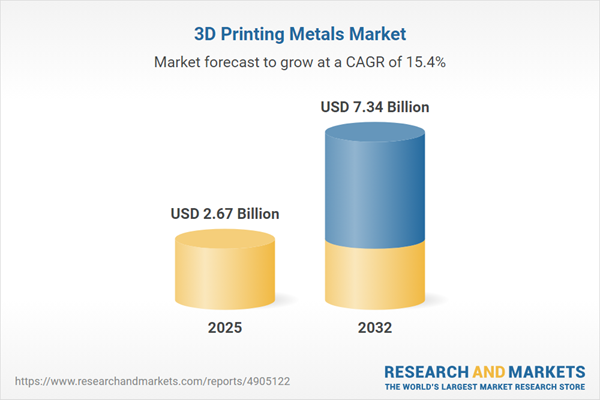Speak directly to the analyst to clarify any post sales queries you may have.
Metal additive manufacturing is rapidly reshaping industrial production, providing new levels of design flexibility and supply chain fluidity across sectors such as aerospace, automotive, healthcare, and energy. Decision-makers are now assessing how advances in 3D printing metals can drive both innovation and operational efficiency in critical applications.
Market Snapshot: 3D Printing Metals Market Overview
The 3D Printing Metals Market grew from USD 2.32 billion in 2024 to USD 2.67 billion in 2025 and is projected to progress at a CAGR of 15.43%, reaching USD 7.34 billion by 2032. Industry growth is being fueled by advancements in powder handling systems, rapid technology adoption, and sustained investment in process reliability and digital integration.
Scope & Segmentation
- Material: Aluminum, Cobalt Chromium, Nickel Alloy, Stainless Steel, Titanium
- Technology: Binder Jetting, Directed Energy Deposition (DED), Material Extrusion, Powder Bed Fusion (PBF)
- Equipment Type: Binder Jet Machines, Electron Beam Machines, Laser-Based Machines, Material Extrusion Machines
- End Use Industry: Aerospace & Defense (Aircraft Components, Defense Equipment), Automotive, Consumer Goods, Energy, Healthcare, Manufacturing
- Application: Industrial End-Use Parts, Prototyping, Tooling (Jigs & Fixtures, Molds & Dies)
- Region: Americas (United States, Canada, Mexico, Brazil, Argentina, Chile, Colombia, Peru), Europe, Middle East & Africa (United Kingdom, Germany, France, Russia, Italy, Spain, Netherlands, Sweden, Poland, Switzerland, UAE, Saudi Arabia, Qatar, Turkey, Israel, South Africa, Nigeria, Egypt, Kenya), Asia-Pacific (China, India, Japan, Australia, South Korea, Indonesia, Thailand, Malaysia, Singapore, Taiwan)
- Key Companies: 3D Systems Inc., BASF SE, Carpenter Technology Corporation, Nano Dimension Ltd., EOS GmbH, Eplus3D, Höganäs AB, Incredible Am Pvt Ltd., Markforged, Inc., Materialise NV, OC Oerlikon Corporation AG, Optomec Inc., Pollen AM Inc., Prodways Group, Proto Labs, Inc., Renishaw PLC, Sandvik AB, Sciaky Inc., Nikon SLM Solutions AG, Steinbach AG, Tethon Corporation, TRUMPF SE + Co. KG, voxeljet AG, Wipro Limited, HP Development Company, L.P.
Key Takeaways for Senior Decision-Makers
- Metal additive manufacturing is enabling industrial players to accelerate prototyping and move toward end-use production, aided by improvements in software integration, process monitoring, and quality assurance.
- Strategic collaborations across materials, equipment, and software providers are shortening time-to-market for new alloys and printing processes, directly impacting supply chain agility.
- Design innovation is evolving; new applications include the production of intricate lattice structures, integrated thermal management, and sensor-embedded components, reshaping traditional manufacturing and logistics models.
- Operational barriers persist around powder costs, capital outlay, equipment investment, and workforce training, making ROI-focused deployment strategies essential for scalable adoption.
- Localized supply networks and the formation of cooperative purchasing agreements are emerging as responses to material pricing pressures and metal tariffs.
- Industry players diversifying portfolios with end-to-end service solutions are gaining stronger customer retention and streamlining workflow efficiencies.
Impact of Recent Metal Tariffs
Newly implemented metal tariffs are creating cost challenges for global additive manufacturing supply chains. Many companies are revising sourcing strategies, expanding joint ventures with domestic powder producers, and exploring partnerships that help absorb input price fluctuations. These changes are promoting regional supply chain resilience and increased focus on process efficiency and powder recyclability. Smaller providers are forming consortiums to ensure feedstock continuity, while larger manufacturers are leveraging scale for inventory and cost stabilization.
Research Methodology & Data Sources
This report integrates findings from in-depth primary interviews with OEMs, material specialists, service bureaus, end users, and regulatory authorities. Comprehensive secondary analysis covers trade publications, patent records, conference materials, and regulatory filings. Insights are validated through quantitative modeling and rigorous quality assurance protocols, including feedback from expert advisory panels and third-party benchmark studies.
Why This Report Matters
- Enables precise competitive benchmarking and strategic planning through comprehensive coverage of market players, segments, and technologies.
- Equips senior executives and strategy teams with actionable insights for risk mitigation and efficient technology investment in the dynamic additive manufacturing sector.
Conclusion
As metal additive manufacturing enters a new phase of industrial relevance, organizations equipped with detailed intelligence and agile strategies will secure growth and leadership in evolving global markets. Continued focus on innovation, collaboration, and efficient supply chain adaptation will define success.
Additional Product Information:
- Purchase of this report includes 1 year online access with quarterly updates.
- This report can be updated on request. Please contact our Customer Experience team using the Ask a Question widget on our website.
Table of Contents
3. Executive Summary
4. Market Overview
7. Cumulative Impact of Artificial Intelligence 2025
Companies Mentioned
The companies profiled in this 3D Printing Metals market report include:- 3D Systems Inc.
- BASF SE
- Carpenter Technology Corporation
- Nano Dimension Ltd.
- EOS GmbH
- Eplus3D
- Höganäs AB
- Incredible Am Pvt Ltd.
- Markforged, Inc.
- Materialise NV
- OC Oerlikon Corporation AG
- Optomec Inc.
- Pollen AM Inc.
- Prodways Group
- Proto Labs, Inc.
- Renishaw PLC
- Sandvik AB
- Sciaky Inc.
- Nikon SLM Solutions AG
- Steinbach AG
- Tethon Corporation
- TRUMPF SE + Co. KG
- voxeljet AG
- Wipro Limited
- HP Development Company, L.P.
Table Information
| Report Attribute | Details |
|---|---|
| No. of Pages | 184 |
| Published | November 2025 |
| Forecast Period | 2025 - 2032 |
| Estimated Market Value ( USD | $ 2.67 Billion |
| Forecasted Market Value ( USD | $ 7.34 Billion |
| Compound Annual Growth Rate | 15.4% |
| Regions Covered | Global |
| No. of Companies Mentioned | 26 |









